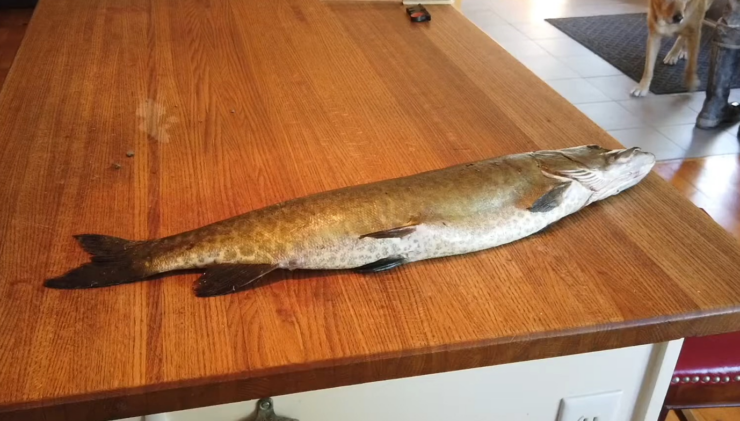Muskellunge, more commonly known as muskie, is a species of fish that has long captivated the interest of us anglers due to its size and elusive nature. Revered as a trophy fish, they are often sought after for the thrill of the catch rather than the prospect of a meal.
However, the culinary potential of this fish is a topic that has been largely unexplored and is ripe for discussion. Some argue that the muskie’s status as a game fish should exempt it from the dinner table, while others are curious about its taste and texture.
This article aims to delve into this topic, shedding light on the culinary potential of the muskie and providing a comprehensive guide on everything you need to know about eating this fascinating fish.
Table of Contents
ToggleWhat Is It?

The muskellunge is a species of large, predatory fish native to North America. It belongs to the pike family and is known for its elongated body, sharp teeth, and aggressive behavior. They are typically greenish-gray to light brown in color, with vertical stripes along their bodies, although some individuals may lack these stripes.
Muskies are found in the northern United States and throughout Canada, primarily in the Great Lakes region. They prefer clear waters with abundant vegetation, where they can hide and ambush their prey. These species are apex predators in their ecosystem, feeding on a variety of fish, as well as frogs, ducklings, and even small mammals.
Their size and elusive nature have made it a favorite target for sport fishermen. A typical muskie measures between 28 and 48 inches in length, but some individuals can grow much larger. The current world record for a caught muskie is a staggering 67.5 inches!
This impressive size, combined with their elusive nature, has earned them the nickname “the fish of ten thousand casts.”
Edibility of Muskie

When considering dining options for certain fish species like the largemouth bass or muskie, one might wonder about their edibility.
There are several myths and misconceptions surrounding the edibility of these species. Some people believe that they are not suitable for consumption due to their size and the potential for high mercury levels. Others argue that the fish’s strong flavor and bony flesh make it less desirable than other freshwater fish.
However, these beliefs are not entirely accurate. While it’s true that larger, older fish can accumulate higher levels of mercury, this is not unique to muskie and is a concern for many types of fish. As for the taste, many people who have tried this fish report that it has a mild, sweet flavor similar to other freshwater fish.
The suitability of this fish for consumption ultimately depends on several factors, including the size and age of the fish, the cleanliness of the water it was caught in, and the individual’s personal taste preferences. With proper preparation and cooking, muskie can be a delicious and nutritious addition to your diet.
Nutritional Profile
Like most fish, muskie is a good source of high-quality protein, providing all the essential amino acids your body needs. It’s also low in saturated fat and contains a variety of vitamins and minerals, including vitamin D, vitamin B12, and selenium.
Compared to other commonly consumed fish, muskie has a similar nutritional profile. For example, a 3-ounce serving of cooked muskie provides about 20 grams of protein, which is comparable to the same serving size of salmon or trout.
However, this fish is lower in omega-3 fatty acids than fatty fish like salmon, mackerel, and sardines. Despite its lower omega-3 content, it can still be a healthy choice as part of a balanced diet. Just be sure to pair it with a variety of other protein sources, including both lean meats and plant-based proteins, to ensure you’re getting a wide range of nutrients.
Cooking Muskie

When it comes to cooking this fish, there are several techniques you can use. Grilling, broiling, and baking are all popular methods that can yield delicious results. The key is to cook the fish until it’s opaque and flakes easily with a fork, which usually takes about 10 minutes per inch of thickness.
Seasoning is another important aspect of cooking this fish. Because of its mild flavor, muskie pairs well with a variety of seasonings. Lemon, garlic, dill, and parsley are all excellent choices that can enhance the natural flavor of the fish without overpowering it.
In addition to these traditional methods, some people also enjoy smoking muskie. This process involves curing the fish with salt and then smoking it over low heat for several hours. The result is a flavorful, smoky fish that can be enjoyed on its own or used in a variety of dishes.
How to Prepare It?
Cleaning and preparing muskie for cooking involves a few steps. First, you’ll need to gut the fish by making a cut from the vent to the head and removing the internal organs. Be sure to dispose of the guts properly to avoid attracting wildlife. Next, you’ll need to remove the skin and scales.
This can be done by making a cut along the back of the fish and then using a knife to carefully peel off the skin. Be sure to remove all the scales, as they can be tough and unpleasant to eat. Finally, you’ll need to filet the fish and remove the bones. Start by making a cut along the spine from the head to the tail.
Then, use your knife to separate the flesh from the bones, working your way towards the belly. Repeat this process on the other side of the fish. When preparing muskie, it’s important to be mindful of the potential for bones. They are known for their Y-bones, which can be tricky to remove. Take your time and use a sharp knife to ensure you remove as many bones as possible.
Flavor and Texture
Muskie has a mild, sweet flavor that is often compared to other freshwater fish like pike or bass. It’s not as strong or fishy as some other types of fish, which makes it a good choice for those who prefer a subtler flavor. Its texture is firm and meaty, similar to halibut or swordfish.
It holds up well to various cooking methods and doesn’t fall apart easily, making it a versatile choice for a variety of dishes. However, like any fish, the flavor and texture of muskie can vary depending on several factors. These include the age and size of the fish, the cleanliness of the water it was caught in, and the time of year.
Personal preferences also play a role, with some people preferring the taste of muskie over other fish, and vice versa.
Health Considerations

While muskie is a nutritious choice, there are a few health considerations to keep in mind. As with any fish, there’s a risk of contamination with harmful substances like mercury and PCBs. These substances can accumulate in fish over time, especially in larger, older fish.
To minimize your risk, it’s recommended to eat a variety of fish and to choose smaller, younger fish when possible. Pregnant women, nursing mothers, and young children should be particularly cautious, as they are more susceptible to the effects of these contaminants.
Another potential risk is the presence of bones. Muskies are known for their Y-bones, which can be difficult to remove completely. Be sure to chew carefully and watch out for any small bones when eating this fish.
Catch and Release Tradition
The tradition of catch and release has been a significant part of fishing for many years. This practice involves carefully handling and releasing the fish back into the water after catching it, allowing it to live and reproduce. The goal is to conserve the species and ensure sustainable fishing practices.
Catch and release became popular in the mid-20th century as a response to concerns about overfishing and the decline of muskie populations. Many anglers embraced this practice, recognizing the importance of preserving this magnificent fish for future generations.
Today, catch and release is widely practiced and is often mandatory in many areas where muskie fishing is popular. Despite the popularity of catch and release, some anglers choose to keep their catch, either for trophy purposes or for consumption.
This has led to a debate within the fishing community about the ethics of harvesting muskie, given their status as a top predator and their role in maintaining healthy aquatic ecosystems. This debate is further complicated by the fact these species are slow to mature and reproduce, making them more vulnerable to overfishing.
However, some anglers choose to harvest their catch, either for trophy purposes or for consumption. If you choose to do this, it’s important to follow all local regulations and to consider the potential impact on muskie populations.
Ultimately, the decision to catch and release or harvest muskie is a personal one that should be made with consideration for both the health of the fish and the sustainability of the fishery.
Local Regulations and Restrictions

Fishing for muskie is subject to local regulations and restrictions, which can vary by location. These regulations may include size limits, bag limits, and specific seasons for fishing. In many areas, there are minimum size limits for the fish to ensure that younger fish have a chance to reproduce before being caught.
There may also be bag limits, which restrict the number of muskies that an angler can keep in a day. In addition to these regulations, some areas have specific seasons for fishing. These seasons are typically designed to protect these species during their spawning period, which is a critical time for the reproduction and survival of the species.
Before fishing for muskie, it’s important to familiarize yourself with the local regulations and to obtain the necessary licenses and permits. This not only ensures that you’re fishing legally, but also helps support conservation efforts.
FAQs:
Can You Find Muskie on Restaurant Menus?
While this fish is not commonly found on restaurant menus, some establishments in areas known for muskie fishing may occasionally feature it as a specialty item.
Can You Eat It Raw?
It is generally recommended to cook it thoroughly before consuming it to ensure food safety.
Can Muskie Be Used as An Ingredient in Fish Cakes or Fish Tacos?
Yes, it can be used in fish cakes or fish tacos, providing a unique flavor and texture to these dishes.
How Should It Be Stored to Maintain Freshness?
The fish should be stored properly in airtight containers or wrapped tightly in plastic wrap, placed in the refrigerator, and consumed within a few days for the best quality.
Is It Commonly Available in Fish Markets?
Muskie is not as commonly available in fish markets as other popular fish species, as it is often caught and consumed locally by anglers.
Final Thoughts

In conclusion, while muskie is primarily known as a game fish, it can also be a tasty and nutritious addition to your diet. With its mild flavor and firm texture, it can be prepared in a variety of ways and enjoyed by both fish lovers and those new to seafood.
However, deciding to eat it is not a decision to be taken lightly. It’s important to consider the health considerations, local regulations, and ethical implications of harvesting the fish.
Discover the 11 best baitcasting reels under $150 in 2024, perfect for budget-conscious anglers and fishing enthusiasts.
Related Posts:
- Heavy Duty Fishing: 11 Best Rods And Reels For Big Fish 2024
- 12 Best Fishing Lures Ever 2024 - Baits That…
- 10 Best Fish Finders Under $200 2024 - Top Affordable Picks
- 10 Best Closed Face Reels 2024 - Game-Changers…
- Can You Eat Largemouth Bass? Absolutely, but…
- 10 Best Saltwater Fishing Boats - Ultimate Angling Adventure












